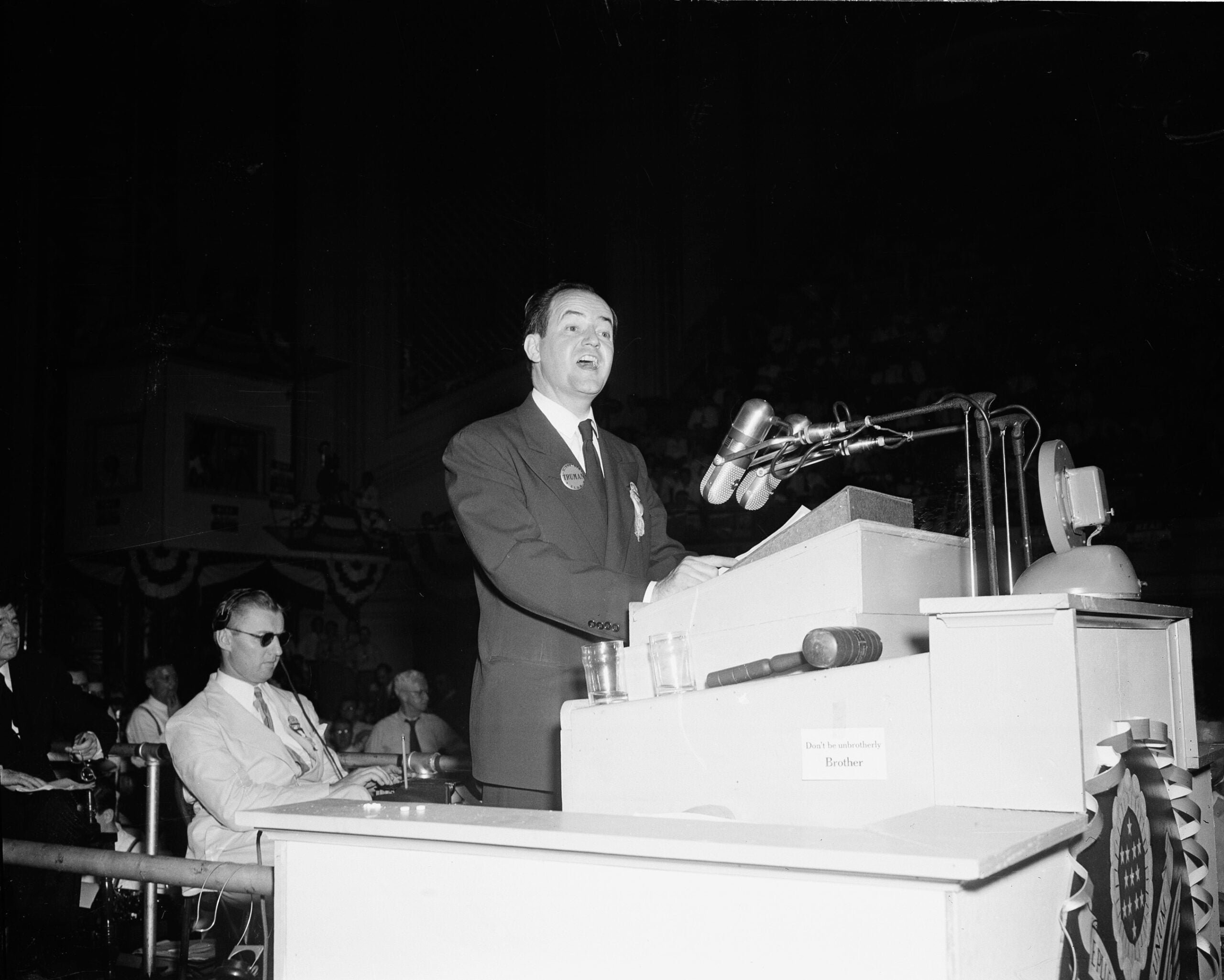For a few days next July, Milwaukee will be the center of the 2024 presidential race as the Republican Party hosts its national convention.
Many political scientists and commentators question whether conventions or debates do much to sway voters. But that hasn’t always been the case.
Seventy-five years ago, a Midwest mayor gave an electrifying convention speech that arguably led to a political realignment that continues today. At the 1948 Democratic Convention in Philadelphia, Hubert Humphrey — then the mayor of Minneapolis — urged his party to take up the cause of civil rights during President Harry Truman’s campaign for president.
News with a little more humanity
WPR’s “Wisconsin Today” newsletter keeps you connected to the state you love without feeling overwhelmed. No paywall. No agenda. No corporate filter.
“The time has arrived to get out of the shadows of states’ rights and to walk forthrightly into the bright sunshine of human rights,” Humphrey said.
The speech led to a temporary split in the Democratic Party and set the stage for the party to lead legislative efforts in the Civil Rights Movement.
Samuel G. Freedman, a journalism professor at Columbia University, explores this history in his new book, “Into the Bright Sunshine: Young Young Hubert Humphrey and the Fight for Civil Rights.”
During an interview with Wisconsin Public Radio’s “The Morning Show,” Freedman said the 1948 convention speech was met with a mix of cheers and hostility.
“We shouldn’t think from the perspective of 2023 that Hubert Humphrey was taking on some safe, pallid, middle of the road issue. He was out there walking the plank and the Southern reaction to it was a sign that the party was going to split over this issue, which indeed happened,” Freedman said. “Humphrey knew that he was taking great risk here.”

Freedman also talked on “The Morning Show” about the significance of Humphrey’s speech, why it matters today and what politicians can learn from Humphrey’s stand.
The following has been edited for clarity and brevity.
Kate Archer Kent: Your book focuses on the struggle for racial and democratic equality in the ’40s. Why is it important to explore this period now?
Samuel Freedman: One of the main reasons is that when people think about the Civil Rights Movement and often write about it, there’s this assumption that it starts in the middle of the 1950s with the Brown v. Board of Education decision by the Supreme Court that outlaws school segregation, Rosa Parks and (Martin Luther King, Jr.), and the Montgomery bus boycott in 1955.
But you really couldn’t have the civil rights landmarks of the 1950s and all the subsequent struggle and achievement if you hadn’t had this fervent decade of activism in the 1940s, a lot of which is really inextricably bound up with World War II and with the concept of defeating fascism abroad and then dealing with the unfinished agenda of inequality in America itself.
KAK: Hubert Humphrey was elected mayor of Minneapolis in 1945. Set the scene for us. What was the racial climate like in the Midwest at that time?
SF: Minneapolis was notorious nationally as a hotbed of antisemitism and racism. It was a city that had been very welcoming to pro-Nazi sentiments in the form of groups like the Silver Shirts and individuals like Gerald L.K. Smith, founder of the America First Party. It was a place in which Black people were able to work, but only in fairly servile occupations, where if they tried to move out of the ghetto on the northside of Minneapolis, there were numerous instances of their homes being besieged by terrorist mobs.
KAK: Southern Democrats opposed civil rights legislation, opposed anti-lynching laws. Can you explain the Democratic Party’s dynamic on civil rights issues in the 1940s?
SF: The New Deal coalition assembled by Franklin Roosevelt had some of the expected components. It had college educated intellectuals. It had Jews and Catholics from big cities who were from immigrant families. It had organized labor. But then it had this one wing that seems completely contradictory, which was the segregationist Democratic Party in the South.
But because the Civil War was associated with the Republican Party and Abraham Lincoln, and so was emancipation and Reconstruction, the white supremacists of the South all flocked into the Democratic Party. And FDR made this calculation — which I would say is almost literally a devil’s bargain — that he would appease and placate the segregationist wing of the party because he felt like he needed the votes from those Southern states to win in the Electoral College to be elected to the White House.
And he needed the support of these very senior, high-ranking Southern senators and representatives in Congress to move New Deal legislation through Congress. And what FDR offered in return was some New Deal programs like Social Security that were written to exclude agricultural and domestic workers, which was to say 90 percent of working Blacks in the South. … Harry Truman is willing to operate on the same playbook, even though it goes against what had been some of his own recommendations on civil rights.
KAK: You write about Andrew Biemiller, who represented Wisconsin in the House of Representatives. What role did Biemiller have in the Civil Rights Movement of the 1940s, and what influence did Biemiller have on Humphrey?
SF: If Humphrey hasn’t gotten nearly enough credit for what he did on civil rights in the 1940s, then Andrew Biemiller is even more obscure to almost everybody. He was a member of Congress from Milwaukee. He’d also been a labor activist. Early in his career, he had been part of the Progressive movement, the La Follette movement in Wisconsin, and served in the state Legislature.
The really important thing that Biemiller does is at the 1948 Democratic Convention, the big issue is going to be civil rights, and the insurgent liberals within the party, including Humphrey, have to figure out how they’re going to be able to get this issue before the whole convention. And one of the ways that Southerners hold great power in Congress and in the Democratic Party is that a lot of them became very expert in these abstruse rules of parliamentary procedure that the party used. It wasn’t Robert’s Rules of Order. It was a variation on it that was even less common.
Andy Biemiller, when he was in Congress, decided to learn these rules inside and out. He learned them from Sam Rayburn, (the leader of the House Democratic Caucus and later House speaker). And so when the insurgents are trying to pass their civil rights plank in 1948 against Truman’s opposition, with the Southerners threatening to walk out, they lose at the committee level, they lose at the platform committee.
In order to take it before the whole convention delegates, Andy Biemiller knows exactly how to play the rules in order to give Hubert Humphrey the opportunity to speak. And when Biemiller goes and presents all the backup number of sponsors and so forth to Sam Rayburn that allow Humphrey to speak, Rayburn is just flummoxed.
He says, “The fat’s in the fire now,” which is a cliche that means there’s going to be a big blaze. But that’s what Biemiller was able to do — give Humphrey the opportunity to give the speech, which would become so famous and so influential.
KAK: Fast forward to today, former President Donald Trump being the frontrunner for the Republican nomination next year, despite facing numerous criminal charges. Trump has been supported by neo-Nazi and white supremacist groups. What could the GOP learn from the Democratic Party of the 1940s in confronting extremist elements within its ranks?
SF: Unfortunately, the GOP seems to be refusing to learn the lesson of the Democrats in the ‘40s. The Democrats were willing at their electoral peril to oust a wing of the party that had an ideology that was toxic in light of the movement for racial and religious equality in this country. At the urging of people like Hubert Humphrey, they pushed out a wing of the party. And even though Adlai Stevenson and John Kennedy tried to bring the Southerners back in, when Lyndon Johnson becomes president, there’s a permanent severing.
Those people in the white supremacist South become part of the Republican Party of today. And today’s Republican Party has obviously refused to reckon with that. It refused to quarantine and to expel racists, antisemites, neo-Nazis, you name it.
Everything’s about the pragmatism of: Can we pull together enough electoral votes to win the White House, even with a minority of the popular vote? Or can we just plain have a coup and take power that way? And if the white supremacists and the neo-Nazis and the Christian nationalists are (Republican) allies in that, then that’s all they care about.
Wisconsin Public Radio, © Copyright 2026, Board of Regents of the University of Wisconsin System and Wisconsin Educational Communications Board.


